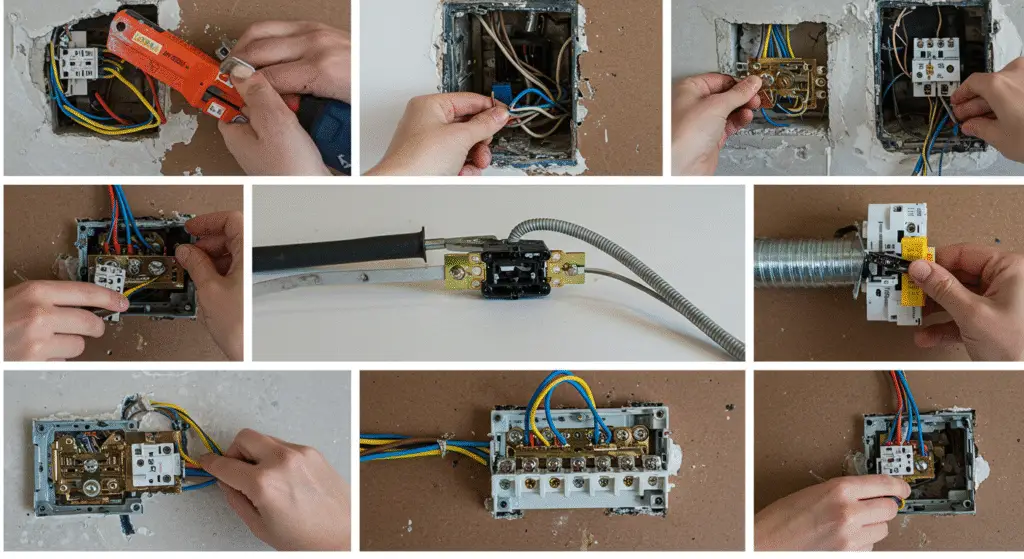How to rewire a house is something many homeowners start thinking about when their lights flicker, breakers keep tripping, or outlets just stop working. Rewiring may sound complicated, but with a clear plan and safety in mind, you can understand the process — and even do some of it yourself.
Whether you’re fixing an old house or just want to upgrade your electrical system, learning how to rewire a house the right way can save money, prevent electrical problems, and make your home safer.
This guide will walk you through the basics, step-by-step, in the simplest way possible.
When should you rewire your home?
There are a few signs that your home’s electrical wiring may be outdated or unsafe. These include:
- Lights that dim or flicker often
- Outlets that spark or feel warm
- Breakers that trip again and again
- Burn marks or strange smells near switches or sockets
- Two-prong outlets instead of modern three-prong ones
If your home was built over 40 years ago and hasn’t been rewired since, it’s a good idea to have it checked out. Older wiring may not be able to handle today’s modern appliances and electronics.
What do you need before starting?
Before learning how to rewire a house, it’s important to gather the right tools and materials. Here are some of the basics:
- Wire cutters and strippers
- Voltage tester
- Screwdrivers
- Electrical tape
- Romex (NM) wiring
- Electrical boxes
- Circuit breakers
- Safety gloves and glasses
- A flashlight or headlamp
Also, check with your local city or town to see if you need a permit to rewire your home. In many places, you’ll need one, and your work may need to pass an inspection when it’s done.
Planning your new electrical system
Before touching any wires, make a clear plan. Think about what you need and where you need it.
Start by walking through your home and marking where you want outlets, light switches, and light fixtures. Some rooms — like kitchens, bathrooms, and laundry rooms — may need extra power for appliances.
Also, consider adding:
- GFCI outlets in kitchens and bathrooms
- USB charging outlets in bedrooms or offices
- Extra lighting for closets or under cabinets
Try to plan for the future. If you might buy more appliances later, it’s better to prepare now.

Turn off the power and remove the old wires
Once you’ve made a plan, it’s time to start. First, turn off the power to your home at the main breaker. Use a voltage tester to double-check that the power is truly off.
Then, remove the old outlets, switches, and wiring. You may need to open walls or ceilings to access everything. Be patient and careful, especially if your walls are old and fragile.
Keep in mind that old wiring may be brittle or unsafe. Always wear gloves, and don’t pull too hard on wires — use fish tape to guide wires through walls safely.
Install new boxes and run wires
Now it’s time to install your new electrical boxes and run fresh wiring.
Use new boxes for outlets, light switches, and lights. These boxes must be placed at the right height and firmly attached. Leave extra wire (around 6 inches) coming out of each box, so you’ll have room to work.
Use wire staples to keep your wires neat and secure. Don’t pinch or crush them. Keep hot wires (usually black or red) separate from neutral wires (white) and ground wires (green or bare copper).
This is one of the longer parts of the job, so take your time and double-check your work.
Connect the wires to the breaker panel
Once all the wires are in place, it’s time to connect them to the main electrical panel.
This part should only be done if you’re confident you know what you’re doing. It’s easy to make mistakes here, and mistakes can be dangerous.
Each circuit will need its own breaker. Follow your plan, connect the wires securely, and label everything clearly. A well-organized panel makes things easier in the future.
If you’re not sure, it’s always smart to call in a licensed electrician just for this step. Safety comes first.
Test and finish the job
Before putting the cover plates back on or closing the walls, test everything. Turn the power back on and try each outlet, switch, and light. Use your voltage tester again just to be safe.
Make sure:
- Outlets work properly
- Lights turn on and off
- Breakers don’t trip when you use things
- GFCI outlets reset and test correctly
Once you’re sure everything works, you can close up the walls and finish the job.
If your area requires an inspection, make sure the inspector approves the work before you finish.
Final thoughts on rewiring your house
Learning how to rewire a house isn’t just about pulling wires through walls. It’s about making your home safer and more reliable. With the right planning, tools, and safety steps, you can understand how the process works and even handle parts of it yourself.
That said, electrical work can be dangerous. If you’re ever unsure, don’t take the risk — get help from a professional electrician.
Even if you hire someone for the hard parts, knowing the basics of how to rewire a house can help you make better decisions, save money, and feel more confident in your home projects.
Common questions
Do I need a permit to rewire my home?
In most places, yes. Check with your local building office.
Can I rewire a house room by room?
Yes, many people do it one room at a time to spread out the cost and effort.
How long does it take to rewire a home?
It depends on the size of the house, but it can take several days to a few weeks.
Does rewiring increase home value?
Yes, newer wiring is a big plus for buyers. It also helps lower the risk of electrical fires.
Is it okay to rewire without tearing down walls?
It’s possible in some cases, especially with basements and attics, but you’ll likely need to cut into the drywall in some areas.
